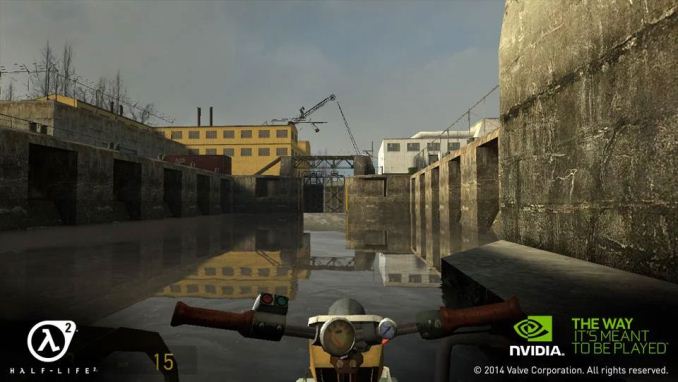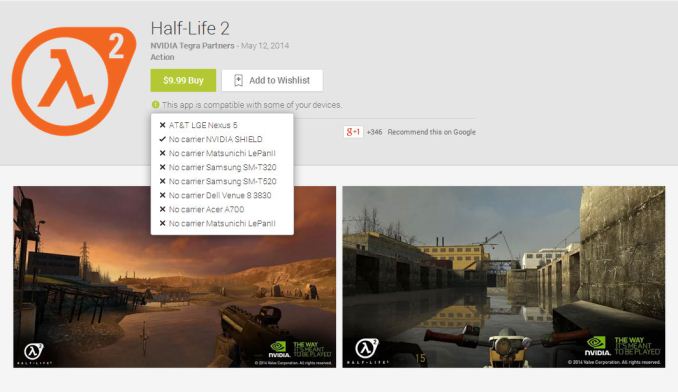SHIELD Gets Portal and Half-Life 2
by Jarred Walton on May 12, 2014 4:49 PM EST
Last week, news came out that Portal is available for SHIELD, which involved NVIDIA sending various members of the press a presumably tasty little cake. (And no, I’m not the least bit disgruntled about not getting one.) It turns out that Portal isn’t alone in the port to SHIELD, as NVIDIA has now announced the availability of the original Half-Life 2 for SHIELD as well. Both games are available via the Google Play Store, but make no mistake: the games require an NVIDIA SHIELD (or at least a Tegra 4 SoC).
System requirements aside, it’s interesting to see that a couple games released in late 2004 (HL2) and late 2007 (Portal in the Orange Box) are now capable of running on a modern SoC. Then again, a state-of-the-art PC at the time HL2 first launched consisted of either ATI’s Radeon X800 Pro/XT or NVIDIA’s GeForce 6800 GT/Ultra. The latter sported DX9-level hardware, with sixteen pixel shaders, six vertex shaders, and sixteen ROPs; ATI’s hardware had a similar 16:6:16 arrangement but with higher clocks generally giving them the edge in terms of performance. In theory, today’s Tegra 4 GPU should be faster than those old chips, but I haven’t seen anything on HL2 benchmarking on SHIELD yet and other elements certainly come into play. I doubt SHIELD is going to be able to run at 120+ FPS at 1280x1024, which is what our old 800 XT/6800 Ultra were able to achieve way back when, but then SHIELD also isn’t going to use a few hundred watts of power.
Perhaps the most bitter pill to swallow with these two SHIELD game announcements is the price: both come at a relatively high (for Android at least) $9.99. That’s the same price you’ll pay for PC versions via Steam, but we’re still talking about $10 each for games most SHIELD owners likely already own – not to mention the games are almost seven and ten years old. If you’ve been living in a cave or somehow managed to miss either game up until now, however, they’re two of the better examples of gaming goodness you’re likely to see, and still a far better value than paying $15 for a two hour movie IMO.
Source: NVIDIA Blog











22 Comments
View All Comments
nathanddrews - Monday, May 12, 2014 - link
"In theory, today’s Tegra 4 GPU should be faster than those old chips, but I haven’t seen anything on HL2 benchmarking on SHIELD yet and other elements certainly come into play. I doubt SHIELD is going to be able to run at 120+ FPS at 1280x1024, which is what our old 800 XT/6800 Ultra were able to achieve way back when, but then SHIELD also isn’t going to use a few hundred watts of power."Sounds like a test worth undertaking, no? ;-)
JarredWalton - Monday, May 12, 2014 - link
I've asked for a game code, but I'd be very surprised if the Timedemo feature is still present. We'll see....ltcommanderdata - Tuesday, May 13, 2014 - link
If you do a benchmark comparison please do a quick image quality comparison too."Then again, a state-of-the-art PC at the time HL2 first launched consisted of either ATI’s Radeon X800 Pro/XT or NVIDIA’s GeForce 6800 GT/Ultra. The latter sported DX9-level hardware, with sixteen pixel shaders, six vertex shaders, and sixteen ROPs; ATI’s hardware had a similar 16:6:16 arrangement but with higher clocks generally giving them the edge in terms of performance."
I'm guessing you meant SM3.0-level hardware for the GeForce 6800 since the X800 was a DX9 GPU as well, just SM2.0b.
ozzuneoj86 - Monday, May 12, 2014 - link
Just FYI, Portal (and the orange box) came out in October 2007, not 2008.It is amazing to think how far mobile devices have come since those days though. I remember getting an incredibly good deal on my eVGA Geforce 6800 GT AGP because BestBuy had them briefly marked down from $399 to $299 on pre-order. Such an impressive card at the time... now you can a cell phone with comparable graphics performance. Though I doubt that they really compare with regard to memory bandwidth. The 6800GT managed 32GB\sec using 256bit 1100Mhz GDDR3... there's no way that current mobile solutions come close to that with their dual channel 64bit (at best) memory controllers... though the newer GPUs probably make better use of what they have.
Truly fascinating stuff to think about... as long as you don't think about how much money you spent on parts back then, compared to how useful they are now.
ozzuneoj86 - Monday, May 12, 2014 - link
Correction... the Tegra 4 only has a dual channel 32bit memory controller. The most recent QualcommSoCs have quad channel 32bit controllers.Still way behind GPUs from 10 years ago... and its shared by an entire SoC.
JarredWalton - Monday, May 12, 2014 - link
But it also only has to drive 1280x720 in most cases (unless connected to a display via HDMI), and other caching "tricks" might help out. But 16 PS and 6 VS from DX9 era you could probably multiply by 4 to get the modern unified shader equivalent performance (minus new features, of course). (Disclaimer: rough estimate may be very off. LOL)Ryan Smith - Tuesday, May 13, 2014 - link
Note that Tegra 4 is not a unified architecture though. It's a rather direct descendant of NV40/6800.JarredWalton - Monday, May 12, 2014 - link
Ah, I used the Portal release date from Metacritic -- forgot to look for a different date on the Orange Box. Updated!darkich - Tuesday, May 13, 2014 - link
That memory bandwidth was an overkill at the time. In terms of GFLOPS though, even the most powerful desktop GPU from 2004 wasn't comparable to today's smartphone counterparts.Think about the fact that even a Mali 400MP4 (Galaxy S3) is able to run graphically improved(draw distance, real time dynamic lighting, enhanced character and car models etc) GTA San Andreas version at maximum settings.
Granted, the frames are pretty low, but again, to run a much lighter version of the same game in 2014 at max settings you needed a beasty desktop machine.
Morawka - Tuesday, May 13, 2014 - link
I bought both! i'm installing them now. Half Life 2 comes in at 2.16GB, and Portal is around 1.XX GB, forgot to look. For $200, you really cant find a reason not to own shield. With all the Console Emulation, + More Source Games Incoming, and lastest version of Android running on amazing hardware, it's hard to find something that will beat it's value.Console Mode turns this thing into a Amazon Fire TV Box basically. Plus there are several features that only Nvidia shield can do. It's been my go to N64 Emulator, and i take it into my room-mates room in console mode to stream Game Of Thrones on HBO GO and Netflix. He also plays Titanfall in console mode streaming from my gaming PC
I cant wait for the Tegra K1 Version. I hope they wait for Denver and use shield as a launch platform, with bigger screen, and possibly 2 camera's for Hangouts/Skype. Even if you dont buy shield for gaming, its basically a portable Roku 3 with a screen + tons of extra's for $100 more. Great Value